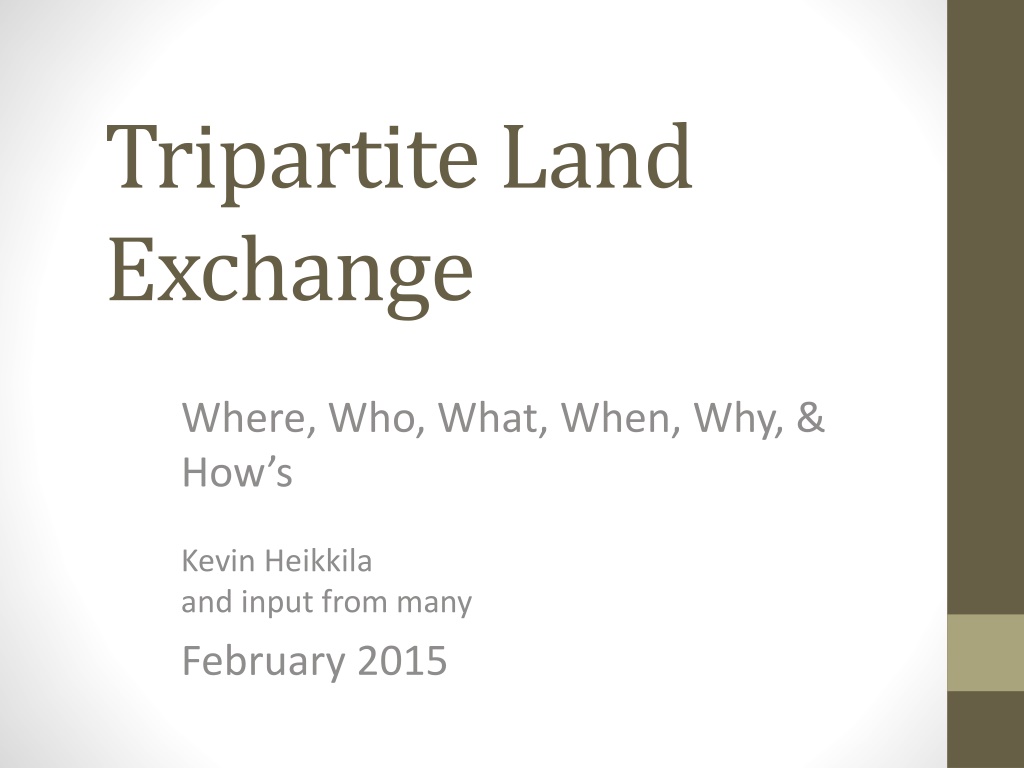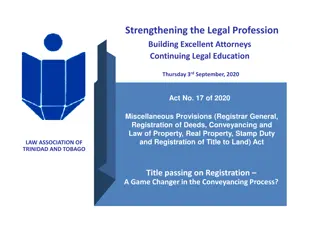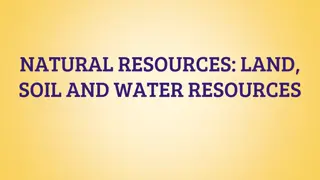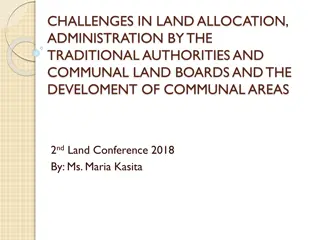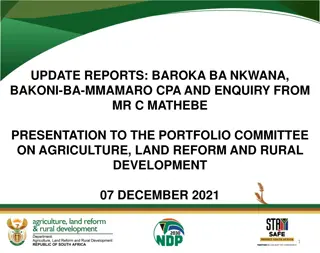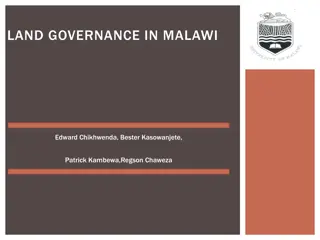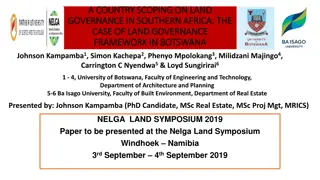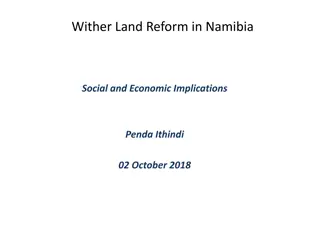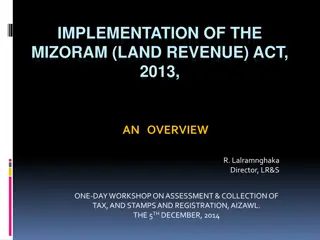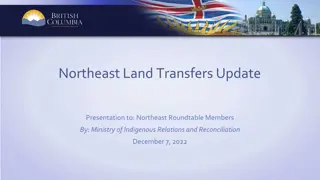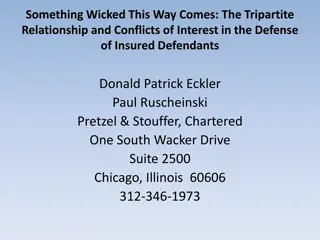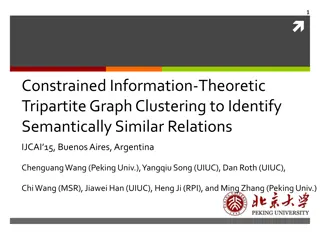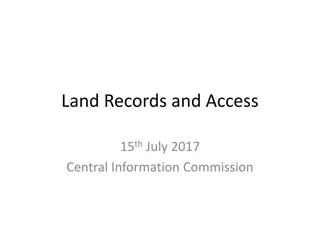Overview of Tripartite Land Exchange Process
The Tripartite Land Exchange process involves the exchange of National Forest System (NFS) land or timber through authorized acts dating back to 1911 and 1922. The exchange can occur within the boundaries of a National Forest, involving various stakeholders including landowners, timber purchasers, and the Forest Service. The process includes delegation of authority, involvement of different parties, and the utilization of a specific clause (C(T) 8.71). This exchange allows for the acquisition of lands for the United States in a structured manner.
Download Presentation

Please find below an Image/Link to download the presentation.
The content on the website is provided AS IS for your information and personal use only. It may not be sold, licensed, or shared on other websites without obtaining consent from the author.If you encounter any issues during the download, it is possible that the publisher has removed the file from their server.
You are allowed to download the files provided on this website for personal or commercial use, subject to the condition that they are used lawfully. All files are the property of their respective owners.
The content on the website is provided AS IS for your information and personal use only. It may not be sold, licensed, or shared on other websites without obtaining consent from the author.
E N D
Presentation Transcript
Tripartite Land Exchange Where, Who, What, When, Why, & How s Kevin Heikkila and input from many February 2015
Authorities General Exchange act of March 20, 1922 (Public Domain Land) Weeks Act of March 1, 1911 (Acquired Land) Both acts authorize the exchange of NFS land or timber
Where can they occur? Within exterior boundary of a National Forest. Same state, not necessarily the same forest.
Current Delegation of Authority -- Chief -- Regional Forester -- R6 Director Recreation, Lands, Minerals, Heritage
Who is involved? 1. The Landowner whose land the US will acquire through exchange . 2. The Purchaser of National Forest timber sale(s). 3. The Forest Service, who will acquire the land.
Who is Involved? Landowner willing seller of their property to the U.S.
Who is Involved? Timber sale purchaser signs timber sale contract thus agree cash paid for timber value to USFS may be placed in a suspense account. Suspense account funds set up via ASC are used to pay the landowner for acquisition of the land.
Who is Involved? Forest Service Staff Forest staff propose lands to acquire. Forest/Lands Zone staff meet & work with landowner to process the exchange. Timber staff insure C(T)8.71 clause is in contract, timber sale receipts are maintained & available for land payment.
What is C(T) 8.71 Clause C(T) 8.71 - Tripartite Land Exchange. (4/99) The purchaser agrees that the cash consideration required by BT 4.0 paid for the contracted timber may be utilized by the United States in a tripartite land exchange where by the United States may assign and pay such funds to a land exchange proponent as consideration for lands to be granted to the United States.
Who is Involved? County Commissioners Should concur with the land exchange. Timber sale receipts go to suspense account, not toward payment to states (25% receipts) fund. Commissioners may not want to see private land go into federal ownership.
Who Else Can Be Involved? Tribes Non Governmental Organizations Others?
Whats Different? NEPA for Tripartite exchange is completed under Timber Sale requirements. Exhibit B of the ATI and Exchange Agreement identifies the timber sale(s) that will contribute to land purchase.
What Else? - Timber Funds September 14, 2001, Memo direction from the Washington Office;
What Else? Not all timber sale receipts are available for tripartite cases. Retroactive dollars (already deposited into Treasury) are not available. Stewardship sales are not eligible.
What Else C8.71 clause can be added through formal contract modifications, with purchaser concurrence if timber has not been removed. No authority to apply the C8.71 provision retroactively once sale volume has been removed. Applies to un-harvested volume remaining on the sale.
What Else? Timber sale will not be considered for tripartite exchange purposes unless total gross stumpage value exceeds the sum of 1) required minimum deposit to NFF, and 2) total planned amount of KV and SFF collection.
Why are they Completed? High priority need (conservation, watershed restoration or other) Opportunity to acquire non-Federal land(s) that may not compete for LWCF Act funds. Appropriate alternative use for timber sale receipts (vs returning to Treasury).
Why Arent They Done More? Timber Sales have not, until recently, generated enough funds to turn back to the Treasury. Until recently, Lands Staff priority work focuses on Administrative Site sales, Encroachments, Rights of Way. Capacity, experience, expertise in staff.
How To Get Started- ID land with willing seller Identify timber sale(s) to be included in the exchange. Initiate a Feasibility Analysis
What Gets Done? Tripartite Exchange Implementation Schedule - steps are followed through Case Closing. Timber sale contracts contribute a portion of their receipts to tripartite exchanges. Contracts must contain enabling contract Special Provision. The current approved provision is C(T)8.71. Non-Federal land is acquired using timber receipts.
Parcels being considered Remember the lands to be acquired have to be within the Exterior Boundary of National Forest System land.
Questions? Question: Does a land purchase have to close before the timber sale contract is closed? Answer: NO - as long as the funds are set up in an account dedicated to that purchase, those funds will be available until expended or returned to treasury, if it is more than the amount needed for the purchase.
